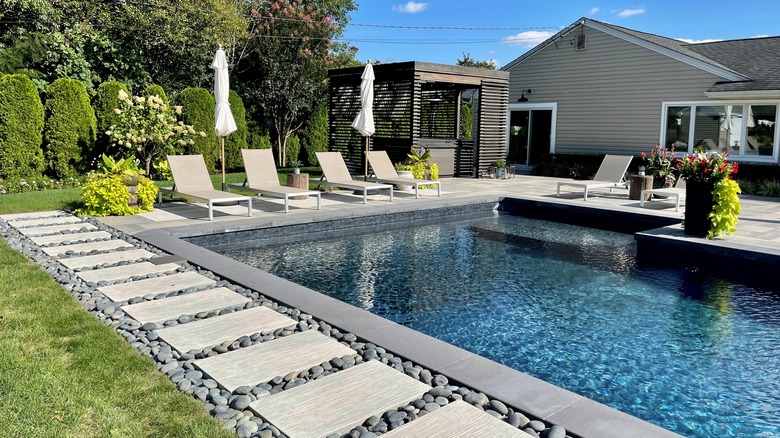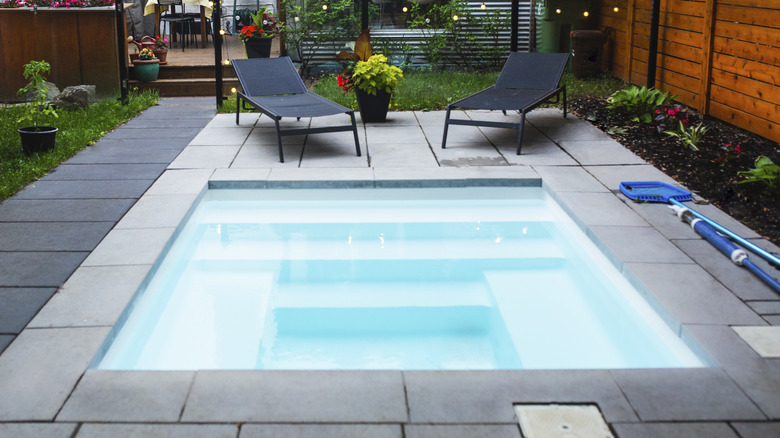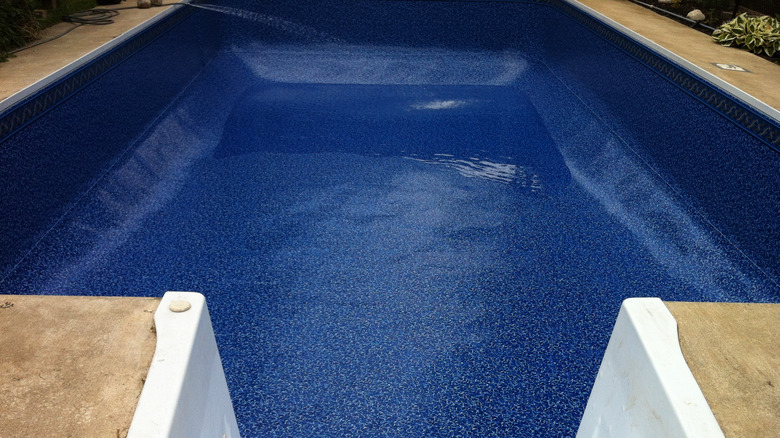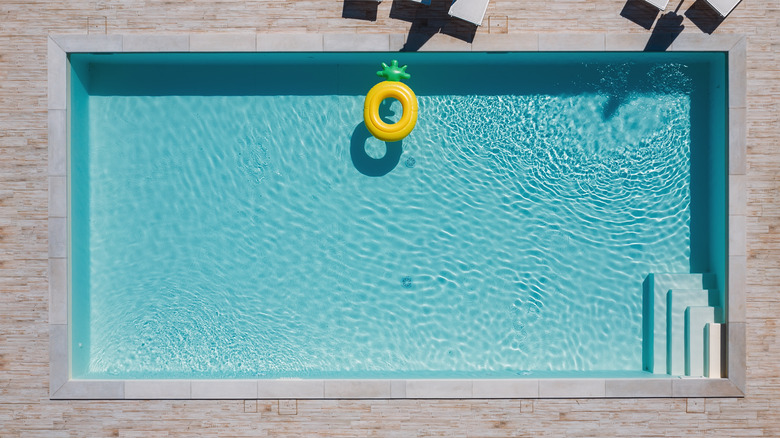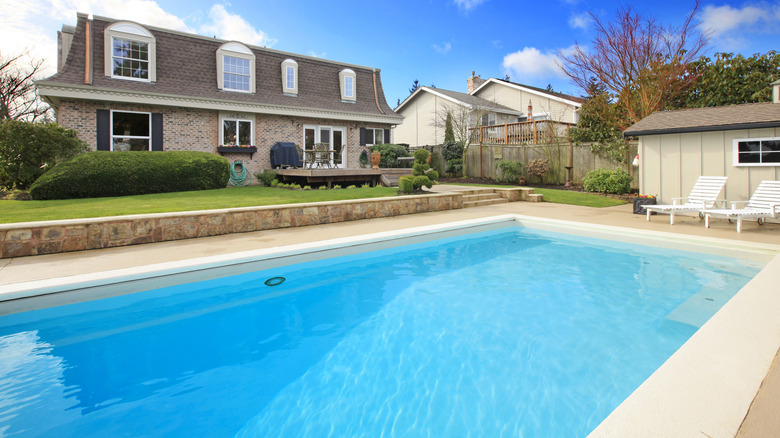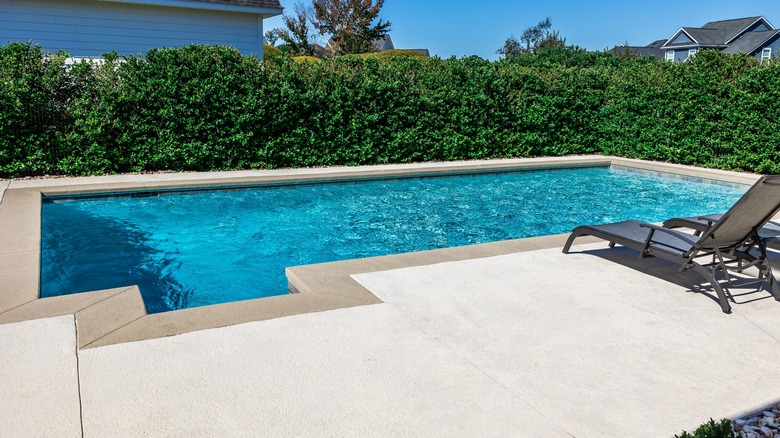Helpful Tips To Keep Your Backyard Pool Ideas On-Budget
Are you finally ready to take that empty section in your backyard and fill it with a design-forward pool? Whether you have kids and want the yard filled with colorful floaties and delighted shrieks or desire a luxurious space you can wade in to beat the summer heat, a pool is an excellent way to help you enjoy your outdoor space more. However, designing the perfect pool for your backyard is one of the more expensive home projects you can take on, so it's very important to stay on-budget to avoid sticker shock at the end of it. Above ground pools can cost anywhere from $1,000 to $6,000, and an inground pool can range anywhere from $44,000 to $86,000. With some careful planning, you can stay on the lower end of these numbers.
For example, to save on your bottom dollar, consider deciding on a smaller size. This will save you cash on materials and labor, lowering your final invoice. You can also cut costs by choosing a more budget-conscious pool material and a simple shape. Further, limiting the size of the deck around the pool and opting out of special features can also save you cash. By making some small, strategic tweaks to your design, you can ensure you create a pool that doesn't completely drain your savings and make you regret taking the project on.
1. Limit the size for an inground pool
While it can be tempting to invest in a sprawling pool, limiting the square footage will help you save large amounts of dough. You may wish you could have enough space to swim laps or to host a large number of people, but choosing a huge pool increases the cost significantly. For example, when looking at a vinyl liner pool, the price will increase as more square footage is added. The average cost for a basic 12x24-foot pool is $45,000, but a 15x30-foot pool jumps up to $55,000. Compare that to a 16x32-foot pool which clocks in over $65,000, and an impressive 20x40-foot one will set you back at least $90,000. The bigger you go, the more eye-watering the price becomes.
Of course, the increase in price is fair due to the extra amount of labor and materials that are needed to accommodate that size. A bigger pool requires more excavation, which means there will be tons of more soil that laborers will have to haul out. You'd also need to invest in more pool tiles as well as coping, which is the concrete trim that hugs the edge of the pool. And, you'd have to invest in more decking since the scale has increased, as well as buy a larger fence and pool cover. And don't forget the amount of water increases. Therefore, keeping your pool small will help you stay on-budget.
2. Choose a more affordable material for an inground pool
The cost to build an inground pool can be anywhere from $44,000 to nearly $86,000, which is a massive range. But the cost varies so wildly because the price is dependent on what you choose to build it out of. The material can either keep you on-budget or blow you right out of the water (pun intended). For example, you can choose between vinyl, concrete, or fiberglass. Each have their own sets of pros and cons that you need to consider, but if you want to stick closely to your financial blueprint, you might want to choose the most affordable one: vinyl.
Vinyl pools are the most budget-conscious. They cost around $36,000 on average with installation and require another $6,000 when it's time to replace the liner in five years. They're the most budget-friendly option because they're the easiest to install since the liner is relatively simple to put in the ground. Concrete pools, on the other hand, usually cost an average of $52,000. They're one of the hardest to install (taking three times longer than fiberglass!), so the price increase reflects that labor. They also need to be resurfaced every 10 years, which typically costs $17,000. Fiberglass pools are a tad more expensive, clocking in at $55,000. They fetch that price due to their high-end appearance and low-maintenance qualities, which is also why they're quickly becoming a popular choice.
3. Avoid curves for an inground pool
When considering swimming pool shapes for your property, you might be tempted to get a curved inground pool. It seems to blend in with the landscape better than a rectangular one, as it's free flowing and organic, much like nature. However, if you want to stay on budget, it's best to skip the soft, winding shapes and instead go with hard lines and boxes. That's because a curvy inground pool can increase your final price anywhere from 10% to 25%. That uptick isn't just because those shapes are popular. It also takes a lot more considerable skill and labor to create such a pool, which increases the price.
Dubbed "freeform" pools, these require more careful excavation since you're following a specific curvy outline. This means that more skilled craftsmanship is required to create the sloping structure and even more skilled labor is needed as well to create the coping and decking that follows those curves. These are also often custom designs rather than prefab liners, so they fetch a higher price tag. Intricate pools also tend to cost more to maintain. Since curvy pools have more nooks, they're generally more challenging to clean, and if they're not maintained properly, you will have to pay to touch up the pool sooner rather than later.
4. Minimize the deck space for inground and above ground pools
Also consider cutting back on the amount of decking that will surround the feature. For an above ground pool, the deck can cost anywhere from $3,000 to $12,000 depending on what material you choose, how big it is, and the complexity of the design. On average, however, expect to spend $5,000. If you don't like that price, then remember that size matters. Decks that are between 300 to 600 square feet cost between $1,000 to $2,000, but 600 to 900 square foot surrounds cost $3,000 to $8,000. Going smaller saves dough. Similarly, an inground pool patio typically costs anywhere from $3 to $40 per square foot depending on material and complexity, so the smaller it is, the more affordable it is.
When designing your pool deck, you can also choose a more affordable material to cut back on costs. For above ground pools, you can use plastic, composite, or wood. Plastic is the most affordable, clocking in between $500 to $2,000 for materials. Composite costs $4 to $12 per square foot, whereas wood is the most expensive, coming in at $15 to $20 per square foot. For inground pools, you can create a patio using either concrete, brick pavers, tile, or rubber. Concrete can cost $4 to $20 per square foot, bricks clock in at $20 to $35, tile can cost $3 to $40, and rubber can be $9 to $20 per square foot.
5. Decide on add-ons later down the road
When you're designing your pool, it can become very easy to get swept away with the details. And if that happens, you can very easily fall out of budget. That's because if you're already paying tens of thousands of dollars, paying an extra $800 for a water feature seems almost affordable. But adding on extra features can quickly add up, ruining your budget. Because of this, consider keeping the design basic for now and deciding on add-ons later down the road.
While you might have to make certain decisions while installing the pool — such as the size, material, and look of the deck — there are other things you can install after the fact. For example, wait a year or two before adding on pricey water slide or decorative fountain to see if you really need it or if you're being influenced to add it on. You can also add certain features like outdoor bars, landscaping, surround sound systems, and deck lights to an existing layout, so they're not something you need to decide on while your backyard is being excavated. Instead, as you save up more money, you can add these features down the road.
